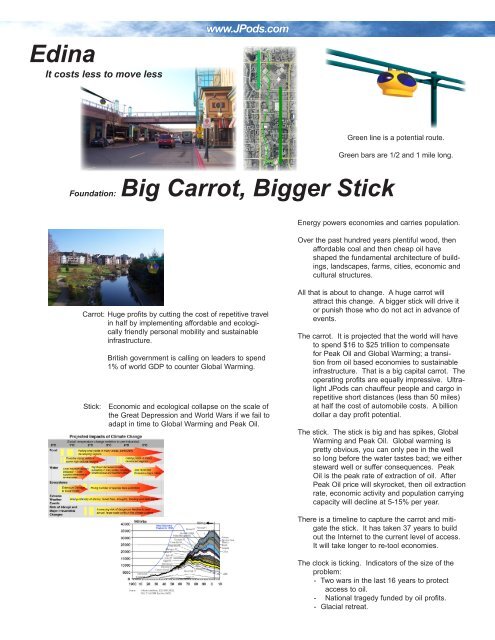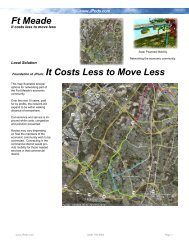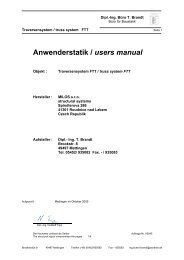Edina Foundation: Big Carrot, Bigger Stick - JPods
Edina Foundation: Big Carrot, Bigger Stick - JPods
Edina Foundation: Big Carrot, Bigger Stick - JPods
Create successful ePaper yourself
Turn your PDF publications into a flip-book with our unique Google optimized e-Paper software.
<strong>Edina</strong>It costs less to move lesswww.<strong>JPods</strong>.com<strong>Foundation</strong>: <strong>Big</strong> <strong>Carrot</strong>, <strong>Big</strong>ger <strong>Stick</strong>Green line is a potential route.Green bars are 1/2 and 1 mile long.Energy powers economies and carries population.Over the past hundred years plentiful wood, thenaffordable coal and then cheap oil haveshaped the fundamental architecture of buildings,landscapes, farms, cities, economic andcultural structures.<strong>Carrot</strong>: Huge profits by cutting the cost of repetitive travelin half by implementing affordable and ecologicallyfriendly personal mobility and sustainableinfrastructure.British government is calling on leaders to spend1% of world GDP to counter Global Warming.<strong>Stick</strong>: Economic and ecological collapse on the scale ofthe Great Depression and World Wars if we fail toadapt in time to Global Warming and Peak Oil.All that is about to change. A huge carrot willattract this change. A bigger stick will drive itor punish those who do not act in advance ofevents.The carrot. It is projected that the world will haveto spend $16 to $25 trillion to compensatefor Peak Oil and Global Warming; a transitionfrom oil based economies to sustainableinfrastructure. That is a big capital carrot. Theoperating profits are equally impressive. Ultralight<strong>JPods</strong> can chauffeur people and cargo inrepetitive short distances (less than 50 miles)at half the cost of automobile costs. A billiondollar a day profit potential.The stick. The stick is big and has spikes, GlobalWarming and Peak Oil. Global warming ispretty obvious, you can only pee in the wellso long before the water tastes bad; we eithersteward well or suffer consequences. PeakOil is the peak rate of extraction of oil. AfterPeak Oil price will skyrocket, then oil extractionrate, economic activity and population carryingcapacity will decline at 5-15% per year.There is a timeline to capture the carrot and mitigatethe stick. It has taken 37 years to buildout the Internet to the current level of access.It will take longer to re-tool economies.The clock is ticking. Indicators of the size of theproblem:- Two wars in the last 16 years to protectaccess to oil.- National tragedy funded by oil profits.- Glacial retreat.
<strong>Edina</strong>It costs less to move lesswww.<strong>JPods</strong>.comGreen line is a potential route.Green bars are 1/2 and 1 mile long.<strong>Big</strong> <strong>Carrot</strong>: Harvesting $ Billion per Day in ProfitsAutomating sewers, water, electricity and communicationsresulted in improved standards of living andeconomic opportunity.Transportation networks are manual and so dangerousthat we have to wrap a person in a ton toprotect them.We waste energy, create congestion, consume realestate and pollute moving a ton to move a person.Repetitive travel is characterized by smog, congestion,road rage and other forms of preemptablewaste.In 2004. according to AAA it cost 57 cents per mile to operatea car. There are 1.08 people per car in rush-hours.<strong>JPods</strong> cost 30 cents per passenger mile to build, operate andmaintain; a profit of 27 cents per passenger mile.Automating highly repetitive travel will preemptmany costs, yielding a profit of about 27 cents perpassenger mile.About 4 billion of the 8 billion miles Americans driveevery day are highly repetitive:- kids to and from school- shoppers to and from retail centers- commuters to and from workNo drunk drivers. No cell phone drivers. You travelon-demand without obligation or risk to others.What applies to people applies to cargo. Palletsize CargoPods move goods on-demand.This billion dollar a day profit potential will create a"green rush" that will impact not just transportationbut all areas of energy use.
<strong>Edina</strong>It costs less to move lesswww.<strong>JPods</strong>.com<strong>Big</strong>ger <strong>Stick</strong>: Global WarmingGreen line is a potential route.Green bars are 1/2 and 1 mile long.Stern ReportAbove all, reducing the risks of climate change requires collective action. It requires co-operation between countries,through international frameworks that support the achievement of shared goals. It requires a partnershipbetween the public and private sector, working with civil society and with individuals. It is still possible to avoidthe worst impacts of climate change; but it requires strong and urgent collective action. Delay would be costlyand dangerous.You can only pee in the well so long before the watertastes bad.Stewardship counts.The Stern Report for the British Government estimatesthat if 1% of world GDP is not invested immediately insustainable infrastructure to contain Green House Gases(GHG) the world will suffer a loss of 20% of GDP.The expectation is that the hardship for failing to act intime will be similar to the Great Depression and WorldWars. For example:- 200 million people will be displaced.- many coastal cities will be flooded.http://www.hm-treasury.gov.uk/independent_reviews/stern_review_economics_climate_change/sternreview_index.cfm
<strong>Edina</strong>It costs less to move lesswww.<strong>JPods</strong>.comGreen line is a potential route.Green bars are 1/2 and 1 mile long.<strong>Big</strong>ger <strong>Stick</strong>: Peak OilOil, the life blood of our economies is a finite resource. Wemust change our economic blood before oil peaks.Discoveries of oil peaked in 1964. Extraction of oil, by eventhe most optimistic estimates, will peak some time in thenext 26 years. When Peak Oil hits, economies desperatefor energy will radically bid up the price of oil.Oil prices have tripled in the last 6 years. After Peak Oilprices will increase radically.It takes years to re-tool infrastructure. It has taken 37 yearsto build out the Internet to the current level of access. It willtake at least 37 years of crash effort to re-tool transportationnetworks to be independent of oil.We should be racing to re-tool like our life depends on it,because it does. After Peak Oil the rate of extraction willdecline just as new discoveries have declined; forcing economicactivities to decline; forcing populations to decline.The rate of decline is estimated at 5-15% per year.Adding the history of each oil field yields a repeating historyof discovery, extraction, peak and decline.ABC's webcast on Peak Oil: http://abc.net.au/4corners/special_eds/20060710/We have the technology to re-tool. We need to do it whileoil is cheap. We are running out of time.Bill James612.414.4211bill.james@jpods.com
<strong>Edina</strong>It costs less to move lesswww.<strong>JPods</strong>.comWhy <strong>JPods</strong>: Reasons to ImplementGreen line is a potential route.Green bars are 1/2 and 1 mile long.1. It costs less to move less.Currently we use energy, pay for infrastructure and createcongestion, moving a ton to move a person.Ultra-light <strong>JPods</strong> approach moving only the person.a. Infrastructure costs are a fraction of heavy infrastructure.b. There is a profit of 27 cents per passenger mile on apotential 4 billion passenger miles per day.2. Congestion mitigation. Congestion cost every worker awork-week per year. <strong>JPods</strong> operate in a different planethan current congestion. Ultra-light nature allows capacityexpansion within the same right of way. Computer controlledadjusts to conflicts far in advance of the event.Streaming resource to need on-demand applies to peopleand cargo. Pallets can move without a truck moving.3. Movability without discrimination. Everyone in the first16 years of their lives and many the last 16 years of theirlives people lose their personal mobility when they do nothave the capacity to drive or own a car. <strong>JPods</strong> providespersonal mobility regardless of age, ability or capacity toown and operated a car.4. Visual Impact. Visual impact is both a problem and benefit.<strong>JPods</strong> will have a visual impact. <strong>JPods</strong> will havea more adaptable visual presense than highways andelevated railroads.5. Economic Opportunity. In a Vermont program 85% ofunemployed people who were subsidized with a car gotjobs and retained employment. <strong>JPods</strong> are affordable.6. Expand energy options. Moving a ton to move a personrequires high density fuel. Low density power sourceslike solar are not practical.Ultra-light <strong>JPods</strong> make low density power sources practical.Solar panels mounted on JPod rails can generate720 kw per mile, a JPod every 32 feet.7. Securitya. Personal. You do not have to share a ride withstrangers. Risks faced by subway and bus riders anddrivers are not a problem for JPod riders. JPod ridersdo not have to wait at a station reducing the risks ofbeing mugged.b. Public. <strong>JPods</strong>, unlike trains and airports are low valuedterrorist targets. <strong>JPods</strong> can be checked at theirload point and cannot be modified without detection intravel. Dispersing the congestion at airports and otherhigh value targets will aid security.c. War. When we are independent of foreign oil we willnot have to defend against oil profit funded terrorismor foreign deployment of troops.8. Rescue-Rail and disaster relief. <strong>JPods</strong> can quickly bedeployed over broke heavy infrastructure to re-establishlogistical and medical support.9. Economic durability (cheap secure oil is gone)a. Peak Oil. The era of cheap securely available oilis over. Every $10 per barrel increase depressesGDP by .5%. Oil shortages and stoppages are likely.Several airlines run on the verge of bankruptcy in partbecause of unstable fuel prices.b. We do not directly produce green house gases.Britain released a report they would take immediateaction to legislate carbon reduction targets and moveEurope toward a goal of reducing carbon emissionsby 30 percent by 2020 and 60 percent by 2050.10. Service. <strong>JPods</strong> provide the service of a chauffeured car.Areas with a high density of shuttles can substantiallyimprove service and cut costs.11. Land use. <strong>JPods</strong> require very little land and can returnto green space a lot of land currently paved. In manycases, as JPod rails are installed, bike paths and walkingareas can be added to otherwise pedestrian hostileroutes.12. Noise. <strong>JPods</strong> are very quiet.13. Cost Effective. <strong>JPods</strong> produce profits and revenuesinstead of requiring subsidies to be built and operated.14. Scaleable. JPod networks can start very small; expandedthem based on payback or niche requirements.
<strong>Edina</strong>It costs less to move lesswww.<strong>JPods</strong>.comGreen line is a potential route.Green bars are 1/2 and 1 mile long.Equity: Opportunity Equates to Personal MobilityPersonal mobility equates to economic, educational andsocial opportuniity.From the Effective Practices Collection, Corporation for National &Community Service:AbstractAccording to the 1990 US Census, thirty percent of New Hampshire residentswho are living in poverty and looking for work do not own vehicles.This does not only affect the economic futures of families; businesses,too, are negatively impacted when employees are unable to get to workon time, or at all, due to chronic vehicle breakdowns and the lack ofaccess to public transportation.ActionThe mission of Wheels to Work (W2) is to promote self-reliance and thedevelopment of a productive workforce in New Hampshire by providinglow-income workers who lack reliable transportation with dependable carsat affordable terms.ContextOf 33 companies (representing 3,344 workers) who responded to a surveyby the Greater Seacoast Transportation Task Force:* Fifty-four percent said that transportation was often or sometimes afactor in their ability to hire new employees;* Forty-five percent said that the lack of transportation resulted inexcessive lateness, absenteeism and job loss among their employees.Source: http://www.seacoastonline.com/2000news/9_10biz.htmOutcomeWheels to Work has been able to deliver vehicles to over 40 low-incomeNew Hampshire families.EvidenceWheels to Work conducted a survey in May of 2001 and maintains regularcontact with all the participants on the road. Over 85 percent of W2participants have maintained employment and all but one have continuedto make an effort on keeping the loan current by making payments to theloan institution.http://nationalserviceresources.org/epicenter/practices/index.php?ep_action=view&ep_id=648Discrimination based on Limited Personal MobilityAfrican Americans have the lowest car ownership of all racial and ethnicgroups in the country, the researchers say, with 19 percent living in homesin which no one owns a car. That compares to 4.6 percent of whites inhomes with no car, 13.7 percent of Latinos, and 9.6 percent of the remaininggroups combined.http://www.berkeley.edu/news/media/releases/2006/03/23_carownership.
<strong>Edina</strong>It costs less to move lesswww.<strong>JPods</strong>.comStudies: PRT is a SolutionGreen line is a potential route.Green bars are 1/2 and 1 mile long.For 50 years technology to revolutionize transportation has beengestating; technologies, materials, safety practices, etc... haveprogressed far beyond barriers of regulated opportunities. Thecrisis of Global Warming and Peak Oil will shred those barriers.There will be a "green rush" to harvest profits by implement whathas been long studied:European UnionContract No. GMA2/2001/52046-S07.13187PRT is the personalisation of public transport, the first public transportsystem which can really attract car users and which can coverits operating cost and even capital cost at a wider market penetration.PRT complements existing public transport networks. PRT ischaracterised through attractive transport services and high safety.A first fully operational system is urgently needed to demonstrateall capabilities and to alleviate some remaining critical issues. Anactive role of all key actors from city level up to the EU level isrequired to facilitate legislation, regulation and financial support.Students at Carleton University experiencing driving a JPodwith a computer network. Smiles are typical.President of Minneapolis City Council, Barbara Johnson:Computerized transit networks or “Physical Internet” will increasepersonal mobility for our school kids, the economically challenged,our senior citizens, the disabled community and those stuck inrush-hour(s) traffic. It will give more people greater access to thefacilities that makes Minneapolis a great city. And in the long run,besides being energy and ecologically efficient, a new job marketwill be created that enhances the attractiveness of living and workingwithin our city.As a City Council Member of our state’s largest city, I firmly believethat strong leadership in a public/private alliance can quickly implementbreak through technologies such as yours. Our communitycan ill afford to wait for another war or another natural disasterto take action. Minneapolis will step up as a leader and supporttechnologies that keeps our air cleaner, our streets less clutteredand creates long-term jobs.The Swedish Agency for Innovation Systems Report VR2001:3Over 80 % of all motorized trips in Sweden are made by car. Cartraffic in cities continues to grow at a rate of about 2 % annually.Road networks in large cities are congested already. Transit ridershipis declining at about the same rate - 2 % annually.The efforts made so far on the improvement of public transporthave been inadequate. Most of those travelling by transit todayhave no other alternative. They lack a driving license or access toa car.Personal Rapid Transit (PRT) is characterized• Small driverless vehicles (3-5 seats)• Off-line stations• Vehicle waiting for passengers• Departure when a passenger is ready• Direct non-stop trips• Quickest route to destination• Opportunities for development by Swedish industry
<strong>Edina</strong>It costs less to move lesswww.<strong>JPods</strong>.comInfrastructure and Operating Costs: Parasitic MassGreen line is a potential route.Green bars are 1/2 and 1 mile long.It costs a lot less to move a person than to movea ton. Yet most personal and public transportationmove at least a ton to move a person. This massis Parasitic Mass. It is the mass we pay to movethat is not cargo or passengers.Worse, every go/stop/go consumes energy to movethis Parasitic Mass.Moving a ton to move a person.Moving 3 tons tomove a person.Driving Parasitic Masstowards zero lowers operatingadn capital costsThe solution is simple. Move less and move it fromstart to destination without stops. That is what<strong>JPods</strong> do; people are chauffeured from origin todestination on-demand.<strong>JPods</strong> infrastructure is so light weight that allaspects of cost are radically less than light rail.In a rail cost per kilometer comparison, Ottawacould have 200 km of <strong>JPods</strong> for the same cost as29 km of light rail.In most cases the entire JPod network can be privatelyfinanced with a payback of 3 to 10 years.Private funding will expand the number of <strong>JPods</strong> onany network.
<strong>Edina</strong>It costs less to move lesswww.<strong>JPods</strong>.comGreen line is a potential route.Green bars are 1/2 and 1 mile long.Process: Concepts Become RealityConnectedThe Wright Brothers did not start by inventing a 747.They implemented a concept that became a process.<strong>JPods</strong> implements the concept that it "costs less tomove less." There will be a running process to develop,deploy and profit by expanding that concept into asustainable future.
<strong>Edina</strong>It costs less to move lesswww.<strong>JPods</strong>.comGreen line is a potential route.Green bars are 1/2 and 1 mile long.Jobs: 1.4 MillionThe transition from oil based to sustainable infrastructureis going to be very disruptive.Many jobs will be created.Many jobs will be lost.As the change from horse to auto changed the jobprofile, so will the change from oil to sustainableinfrastructure.Cities that lead the change will capture a greaterpercentage of new jobs.Peak Oil component alone is estimated by RobertHirsh to be 1.4 million new jobs.British Stern report calls for a 1% of world GDP tobe spent.Cities that lead in this shift will capture jobs andindustries.
<strong>Edina</strong>It costs less to move lesswww.<strong>JPods</strong>.comGreen line is a potential route.Green bars are 1/2 and 1 mile long.Capital Opportunity: $16 to $26 Trillion Green RushThe Stern Report from England calls for a 1% ofworld GDP investment to mitigate a loss of 20% ofworld GDP to Global Warming.Peak Oil estimates by Robert Hirsch, a contractorfor DOE outlined the cost to re-tool energy at $16-$25 trillion.The gold rush in the modern economy will be agreen rush to capture these re-tooling investments.Cities that lead the way will create the industriesthat capture more of these dollars.
<strong>Edina</strong>It costs less to move lesswww.<strong>JPods</strong>.comGreen line is a potential route.Green bars are 1/2 and 1 mile long.Green Space Recovery: Real Estate PollutionBy some estimates, up to 52% of urban real estateis consumed supporting cars.Considerable amounts of land can be redevelopedinto useable and green space.<strong>JPods</strong> can be deployed to recover green space.
<strong>Edina</strong>It costs less to move lesswww.<strong>JPods</strong>.comGreen line is a potential route.Green bars are 1/2 and 1 mile long.Deployment Conflicts: Winter and Road ConstructionA standard joke in northern climates is there aretwo seasons, winter and road construction.<strong>JPods</strong> do not operate in the same plane as currentcongestion.Being ultra-light <strong>JPods</strong> can be constructed withoutsubstantial disruption to the existing traffic patternand at a rate of miles per day per installation team.As private enterprise where construction time consumesprofit, <strong>JPods</strong> will minimize construction time.In modern times, government contractors maytake 4 years to build 10 miles of light rail. Thatis because we decide it should take so long, notbecause it does. On April 28, 1869 a crew from theCentral Pacific laid 10 miles of heavy rail betweensunrise and sunset. CP was privately financed.As we get our deployment techniques well honed,<strong>JPods</strong> should be able to deploy rail, knitting a citytogether at an amazing rate.
<strong>Edina</strong>It costs less to move lesswww.<strong>JPods</strong>.comCongestion: Work-week per YearGreen line is a potential route.Green bars are 1/2 and 1 mile long.Congestion costs the typical worker 43 hours peryear.A work-week per year loss. This equates to a 2%tax on working. In cities like LA or New York thecost is double.Commuting to work by bus takes about twice aslong as by car. Delays are a tax on time.<strong>JPods</strong> provide the personal mobility of a car withoutthe requirement to park or operate it.As cars only operate where there are roads, <strong>JPods</strong>will only operate where there are rails (or roadswhen combined with a carrier).<strong>JPods</strong> can be both private and public.
<strong>Edina</strong>It costs less to move lesswww.<strong>JPods</strong>.comSafety: 9,000 Times SaferGreen line is a potential route.Green bars are 1/2 and 1 mile long.Auto Deaths in Minnesota11.12 per 100k557 deaths in 2004Economic cost $3.065 billionWuppertal, Germany105 years1.5 billion passengers4 deathsRoller coaster (9,000 times safer than cars)One death per 90 million34 deaths in last 26 years (most from suicidal orintentionally unsafe behavior).<strong>JPods</strong>Slow, low G-Force roller coaster mechanicscombined with automated computer control.
<strong>Edina</strong>It costs less to move lesswww.<strong>JPods</strong>.comGreen line is a potential route.Green bars are 1/2 and 1 mile long.Energy: SolarMoving massive vehicles required high densitypower sources.Parasitic Mass requires far move power to movethan is required to move the people in the vehicles.Moving a ton to movea person requires highdensity power sources.Ultra-light <strong>JPods</strong> makelow density powersources viable.Driving Parasitic Mass towards zero makes lowdensity power sources, such as solar and wind,more viable.Putting solar collectors on JPod rails to provideenvironmental protection can provide about 720 kwper mile; enough to power <strong>JPods</strong> moving 32 feetapart.Wind and solar are highly distributed power sources.<strong>JPods</strong> transportation networks have highly distributedpower needs. Power can be captured andused where it is generated.There is not so much a shortage of energy as acollection and distribution problem.
<strong>Edina</strong>It costs less to move lesswww.<strong>JPods</strong>.comWhat Works: Natural ModelGreen line is a potential route.Green bars are 1/2 and 1 mile long.First network agreementWater Park of America toMall of AmericaNature provides good examples.Delivery systems in nature stream resource to needon-demand. As demands change, streams adjuststo the priorities.Packet size matters:The 20 trillion red blood cells in your body needto be small so they can pick-up and deliver ondemand.If your red cells had a hundred times theircarrying capacty but were 5 times their size, youwould be dead.A city or town is not much different than a body.Resources must stream to need. Waste muststream away.We have implemented streaming infrastructuresin water and sewers. Few would tolerate gettingwater delivered periodically or waiting a week tohave waste and urine removed.US transportation developed mimic the flow innature. When there is no traffic cars are amazinglyvaluable at getting people where they need to be.It is why they command a 97% market share in theUS and an 80% market share in Europe.Packet size matters:Experience defined the correct size packet for movingpeople: a horse, cart, chariot, buggy and automobile;a packet size of 1 to 4 people.Building a circulatory networkfor cities and towns.On-demand:Resource streams to need.Waste streams to disposal.Cars are the right answer, 1 to 4 people; cars arejust the wrong mass and randomness of behaviorfor areas with higher human density. Just as youwould die if your red cells were 5 times their size,our cities choke with congestion when we move aton to move a person.<strong>JPods</strong> are about a fifth the mass of a car with aboutthe same interior and load carrying capacity.
<strong>Edina</strong>It costs less to move lesswww.<strong>JPods</strong>.comGreen line is a potential route.Green bars are 1/2 and 1 mile long.What Works: Just-in-TimeBenefits of shifting from Mass Production to Just-in-Time can be gained byshifting from Mass Transit to Personal Automated Mobility.Manufacturers experienced great productivity gains moving from MassProduction (focus on the capital asset) to Just-in-Time (focus on the quality,continuous flow and value of the process).Here is a typical impact on a company in the early 1990's when they shiftedfrom Mass Production to Just-in-time continuous flow ((Womack, Jones, 1996)Batch & Queue/1991 Flow/1995Development time for a new product family 3-4 years 1 yearEmployee hours per machine 160 80Manufacturing space per machine 100 square feet 55 square feetDelivered defects per machine 8.0 0.8Production throughput time16 weeks 14 hours to 5 daysProduct delivery lead time 4-20 weeks 1-4 weeksForty-eight U.S. companies using Just-In-Time work teams report (Waldo,1991):- 35% reduction in cycle time- 24% reduction in late deliveries- 30% reduction in hours/unit,- 33% reduction in work-in-progress inventories- 58% reduction in scrap rates- 71% reduction in customer complaints- 39% reduction in floor space requiredReference: Applying Lessons from Lean Production Theory to Transit Planningby Dunning and Richert.For some it is counter-intuitive that moving smallvehicles can move more people and cargo thanlarge vehicles.Seeing a packed train or bus we can see a lot ofpeople moving at one time. But most of the timethe right-of-way used is empty, no one is moving.Tracks stand empty as people waste time waitingfor the next train.With <strong>JPods</strong>, as with automobiles, there is no waitingat a station for a scheduled departure. Whenyou arrive at a station you get into a waiting JPodand leave for your destination. The right-of-way inin use on-demand.This streaming of resource to need on-demand hasfar greater carrying capability than batching peopletogether. We see this every day. Cars are smallpackets streaming resource to need on-demand.Even in Europe with extensive train systems, carsaccount for 80% of trips.<strong>JPods</strong> have the same typical carrying capacity ascars. They stream resource to need on-demand.Time is money. All those people waiting at a busstop or waiting for a train are spending money.There is a profit in saving people time and money.Comparison of seats per hourSeats Frequency Seats per hourBus 50 5 mins 600Light Railo 200 10 mins 1200 200 10 mins 1200<strong>JPods</strong>, Ultra and other PRT 4 3 secs 4800Being Ultra-light and on-demand, service is available 24 x 7.
<strong>Edina</strong>It costs less to move lesswww.<strong>JPods</strong>.com<strong>Foundation</strong>: Waste Not, Want NotGreen line is a potential route.Green bars are 1/2 and 1 mile long.Pollution indicators wasteful use of a resource.If you used only what you needed to use therewould be no residue.In repetitive travel we consume energy and createcongestion moving a ton to move a person;approaching moving only the person preemptsthose costs.Using less energy produces less pollution, GreenHouse Gases.There is a profit in preempting waste.
www.<strong>JPods</strong>.com<strong>Foundation</strong>: EconomyCurrent RisksCommon replies to Peak Oil, terrorist threats and Global Warming threats are there is plenty of oil shale and oil sand. This may betrue, but it is also true there are starving people in the world yet there is plenty of corn in Iowa. If a necessity is not available whereit is needed; if it cannot affordably be transported to where it is needed; it is irrelevant to a crisis.Our economy depends on cheap, securely available oil. With current demand, cheap oil (under $70 per barrel) is not in our future.Secure access to all the oil we want ended forever in 1973. We have to think differently.ActionIt will take 15 to 50 years to re-tooling transportation so necessities can flow to need without cheap oil. We can build a Physical-Internet, stream packets on-demand, change commuter mobility from moving a ton to move a person towards moving only the person.Automating repetitive transport provides mobility while allocating cheap oil to those functions that cannot operate without it.If a farmer does not have cheap oil to plant next spring, food will not be grown. If a trucker does not have affordable oil, food will notbe moved from farm to table. Commuters compete with farmers and truckers for cheap oil.How long will your job be secure if farmers cannot plant? If truckers cannot deliver? Oil tripled in price since 2000. It will take lessthan 6 years to triple again. If trucks stopped running what would you be eating in 12 weeks? All the corn in Iowa will not feed asingle person in Chicago without cheap oil to harvest and deliver it. Again, oil tripled in price since 2000. Act before the crisis.Following is a model of the economy. Farmers, miners, manufactures and mothers are at the foundation of this model, people thatadd profound value to a raw natural resource. The expanded structure of the economy indicates how we leverage natural resourcesand why the worst famines of the 20th Century happened in more complex economic structures; in a collapse, millions of peoplemust compete for survival in a very small natural resource footprint.Nature of an EconomyThe economy is a confederation of upside-down pyramids.Natural resources- Life depends on nature; clean air, clean water, sun light, etc..., threads with which we weave our lives, social and economicstructures.Individuals- The economy is a confederation of working individuals who profit by adding more value than the cost to compete.- Each individual is an upside-down pyramid:- The base, resources consumed to compete.- Our outstretched arms are the value we add. How far they extend depends on our will and ability to trust, transact, andtransport that added value.- Power is the will and ability to act applied to achieving an objective (Clausawitz). At a fundamental level, self-interest suppliesthe components of "will and ability". Individual self-interest powers the economy.Industries and Communities- Self-interest dictates cooperation and collaboration. My interestes are best served by focusing my time and resources throughmy strongest talents. I rely on the talents of others to grow food, mine mineral, have babies, manufacture goods, protect usand other needs and wants of our physical and social nature.- Individuals form alliances, communities, industries, nations; specializing, amplifying individual value added and driving downthe cost to compete.- The value of these structual componets, their profit, is the value they create minus the resouces consumed to compete fortheir existence.- These institutions are powered by their members; held together by abilities to trust, transact, and transport that added value.- Bill JamesThe EconomyIn Defense of the RepublicThe economy is constantly churning. Individuals and institutions scramble to sustain their base, exploit their talents and build relationshipsthat amplify those resources. Driven by the will and ability to Transact, Transport and Trust knits the economy into being:©2006Worst famines occur whenTrust: Risking that someone else will deliver value more than harm is essential; giving terms in complex a contract, economies investing collapse instock. Trust expands slowly with good experience. evaporates with bad. Strong self-confidence, self-reliance andshared objectives expand trust.Transact: Specialization requires trading resources with others to cover all needs and wants.Transport: Resources must flow to need. Just as your body needs a circulation system to stream resources to need and wasteto disposal, the life of a complex economy depends on transport.ContactBill James, bill.james@jpods.com, (612) 414-4211 Sept 6, 2006








